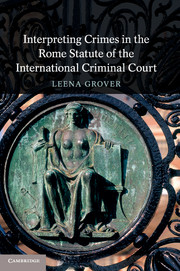Book contents
- Frontmatter
- Dedication
- Contents
- Foreword
- Acknowledgements
- 1 Introduction
- 2 The state of the art
- 3 Guiding interpretive principle
- 4 Challenges to the principle of legality
- 5 Operationalizing the principle of legality
- 6 Custom as an aid to interpretation
- 7 Internal indicia of codification
- 8 External indicia of codification
- 9 The Vienna Convention (1969) and aids to interpretation
- 10 Conclusions
- Bibliography
- Index
- References
8 - External indicia of codification
Published online by Cambridge University Press: 05 November 2014
- Frontmatter
- Dedication
- Contents
- Foreword
- Acknowledgements
- 1 Introduction
- 2 The state of the art
- 3 Guiding interpretive principle
- 4 Challenges to the principle of legality
- 5 Operationalizing the principle of legality
- 6 Custom as an aid to interpretation
- 7 Internal indicia of codification
- 8 External indicia of codification
- 9 The Vienna Convention (1969) and aids to interpretation
- 10 Conclusions
- Bibliography
- Index
- References
Summary
Introduction
In the previous Chapter, codification indicia that are largely internal to the Rome Statute were examined in order to discern whether crimes in the Statute are reflective of custom. This codification study is motivated by the need to determine the role that custom should play as an aid to interpreting these crimes. To the extent that the definitions of these crimes are reflective of custom, it can be argued that custom is an aid that must be considered when interpreting them. This inquiry is also undertaken to assist in determining what the relationship might be between custom and the Elements of Crimes as aids to interpretation, the latter being essential. Recall that judges must consider the Elements pursuant to article 9(1) of the Rome Statute when interpreting articles 6, 7, 8 and 8 bis. In this Chapter, the codification study will be completed by analyzing the following indicia: drafting history of the Rome Statute and Final Act of the Rome Conference; ratifications, reservations, denunciations and revisions; the conduct of States and Non-States Parties; jurisprudence on the (non-)codificatory nature of crimes in the Rome Statute; and doctrinal writings on this matter. Broadly speaking, these indicia may be characterized as external to the Rome Statute.
Drafting history
In this section, the travaux préparatoires of the International Law Commission (ILC), the pre-Rome drafting bodies and the Rome Diplomatic Conference will be combed for evidence of the nature of the Rome Statute and whether drafters intended for it to reflect customary international law. In doing so, the following two streams of legal development will be canvassed: (1) efforts to codify international crimes and (2) efforts to establish an international criminal court. Although these efforts seem to converge with the drafting of the Rome Statute, they were previously treated by those involved as two distinct legal tasks, as will be explained below. This section is written chronologically while trying to maintain a distinction between these two streams of development. And since this history is well rehearsed in many other places, the focus of this section is really to extract from that material that which is relevant to the question of the relationship between the Rome Statute and customary international law.
- Type
- Chapter
- Information
- Publisher: Cambridge University PressPrint publication year: 2014



